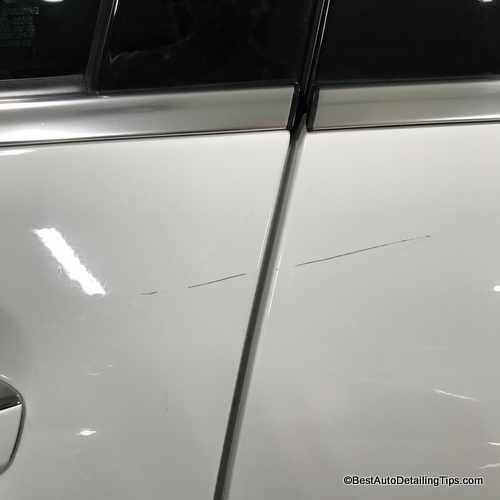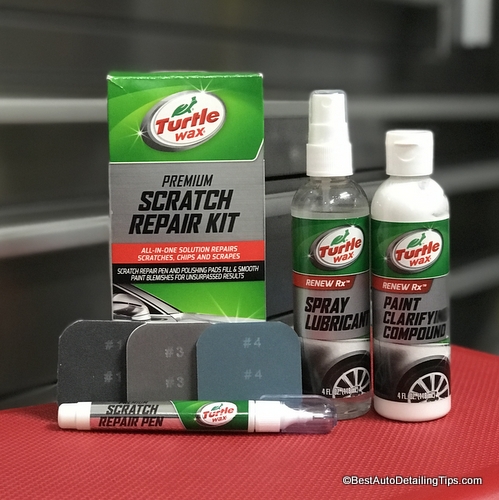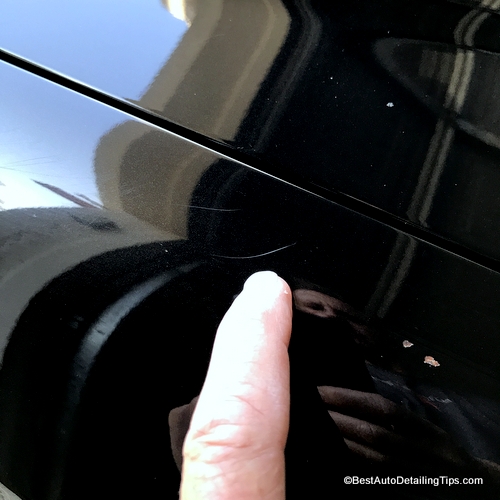Clear Coat Scratch Repair:
The cold truth!
Welcome to clear coat scratch repair where I am about to deliver the cold truth on a subject that has endless opinions and endless strategies.
As the messenger of some bad news, most of you will spend more time than you want to, reading or watching the endless bad info on how to repair clear coat scratches, and still be disappointed when all is said and done.

It's not that no clear coat scratch repair methods don't exist, it's just that most of these methods will be sold to you by exploiting the fact that you don't know enough to even ask the right questions.
This simply means you are at the mercy of companies trying to sell you their special polish, compound, or clear coat scratch repair kit.
It's known as marketing.
Clear Coat Scratch Repair:
Why you will be disappointed
I could reduce these reasons down to 3 specific points:
- Your lack of understanding
- Your unrealistic expectations
- Your inexperience
Let's unpack this subject and get enough understanding into your head so you at least have a fighting chance of success, as well as have more realistic expectations.
Which all leads to you being less disappointed, not more disappointed.
"There is no repair method that will fix every clear coat scratch, in every situation"
Before I discourage you completely, just know that in most clear coat scratch repair cases, you may not be able to repair the scratch perfectly, but mild to massive improvements ARE definitely possible!
I want to break this down from most basic and least aggressive, to full potential. Most of the information and instruction will be based on using the Turtle Wax Scratch Repair Kit listed below.
Clear Coat Scratch Repair Kit:
My first responder for fixing car paint scratches and "skid marks"
Despite any of the negative reviews you might see on Amazon regarding this kit, I consider this kit an amazing solution for any motivated do-it-yourselfer.
Based on the reviews I have read I can tell that virtually every one of these is due to either not following directions, or lack of understanding of the nature of clear coat scratches which then leads to unrealistic expectations that would be unmet with any repair kit.
This kit literally contains mini-versions of the very products and tools I use as a professional when dealing with the endless types of scratches in car paint or clear coat (which is actually the same thing since virtually every car made since the mid-eighties will have a clear coat as the top coat).
Turtle Wax T-234KT Premium Grade Scratch Repair Kit
What This Kit Contains and Why This Is Important:
Clarifying Compound: While this is officially meant to be used to remove the sanding marks after using the provided sanding discs, this Clarifying Compound is my official First Responder to the many types of paint scratches, paint transfer, and general "skid marks" you will find when examining your car paint.
Also useful if you are especially afraid of using the sanding discs or the clear coat touch-up pen at the beginning when attempting any clear coat scratch repair.
Using the Clarifying Compound first will allow you the least aggressive approach to help determine the extent of the damage. And if you are lucky, you might just find that using the Clarifying Compound will be all that is needed to either remove the damage, or diminish enough to meet your satisfaction.
Darren's Tip: Test out any scratch by using the clarifying compound first and use with a micro-fiber cloth. Yes, you can use any cloth you want, but micro-fiber cloths are the safest cloth for use on clear coat.
Simply apply a small pea size drop of compound to the cloth and proceed to rub back and forth across the scratch once the paint surface has at least been wiped clean. Rub back and forth about 20 times with medium pressure while checking results as you rub to see if the scratch appears to diminish in appearance.
After your initial rubbing, use dry side of micro-fiber and wipe clean to check results. You are safe to literally rub as hard and as many times as you like. It would be virtually impossible to do any real damage to your car's clear coat simply using this Clarifying Compound by hand.
Not all scratches are created equally. This simply means there will be scratches that are extremely superficial and can be removed with this very basic method, and scratches that prove too deep for this alone and will require the use of the sanding discs.
But you will likely appreciate at least experimenting with the least aggressive method. And you will want to do this to any of the specific clear coat scratches, skid marks, or paint transfer you will comes across as you work your way around your car.

Sanding Discs: This kit contains 3 different sanding discs. The discs are numbered from 1-4 indicating the order in which to use them. One of the discs (1 and 2) are actually two different grits put onto a single disc.
The discs will be your next step to any clear coat scratch repair that cannot be treated with the Clarifying Compound alone. This clear coat scratch repair kit comes with a spray lubricant to be used while sanding the paint scratch you are attempting to repair.
You could literally pick any disc you want to start with, but the concept of the multiple sanding discs is to start with the most aggressive disc, then work down through the lesser aggressive discs.
At that point you use the Clarifying Compound as described just above to polish away any of your sanding marks. What you need to know is that you will have to rub much harder and more aggressive than you likely imagine when using the Clarifying Compound to remove the sanding marks.
Darren's Tips: Using these sanding discs for the first time will be very disturbing for you. This is literally taking extremely fine sand paper to your car paint. You will create a dull patch as a result of the sanding process.
What you are doing is sanding the clear coat to level the area to the deepest part of the scratch you are attempting to repair. You do this using the abrasive particles of the sanding disc to "wear away" the surrounding clear coat material.
Once the sanding has been done
per instructions, then you will have essentially down just about all you
can with regards to sanding the area before you polish your paint back
to full luster using the Clarifying Compound.
Clear Coat Touch-up Pen: I only recommend using this touch-up pen as a last resort. The clear coat solution comes out very quickly and will drip when using on any surface that is less than completely flat.
Due to the excessive solution that comes out, any excess will naturally flow with gravity. While this pen will prove very temperamental to you in most cases, it can provide rather amazing results if you can finesse the moment.
Unfortunately there is no sure indicator as to when to use this and when not to. If you do use this pen and you cannot achieve desired results, you can use finger nail polish (finger nail polish cannot be the "acetone free" type) or acetone to remove your clear blob.
Once again it is important to remember that not every scratch can be repaired perfectly, some can only be improved, and sometimes you may simply lack the skills to maximize the results of this kit or any other clear coat scratch repair kit.
Clear Coat Scratch Repair:
Becoming an informed car owner
If you are still reading, then you can consider yourself an anomaly among car owners and people in general. Most people are looking for a short-cut to everything in life.
Most people simply do not do the details of life. This includes the details of learning.
Any discussion on clear coat scratch repair will naturally cause many other questions to arise either before you attempt the scratch repair, during the repair, or immediately after.
For this reason I will add some additional depth of understanding to this topic.
What is Clear Coat
Clear coat in simplest of terms is traditional car paint with no pigment (color) added to it. Clear coat is the top layer of any paint system that has been applied at the factory.
When people talk of car paint scratch repair and clear coat scratch repair, they are literally the same thing. Based your understanding of factory paint systems will largely determine how you came searching of answers on how to fix or repair scratches in your car paint.
What this also means is that literally any method you would or could use to fix a car paint scratch, would be the same as trying to fix a clear coat scratch.
Clear Coat is Thin
What you also need to know is that factory clear coat is very thin. Not only is clear coat much thinner than most people realize (imagine the thickness of a Sticky Note...which is actually thicker than most clear coats).
What you also need to know is that clear coat is what creates the true depth and gloss of the color or base coat that it sits on. What this also means is that if you were to sand or polish your car paint in an attempt to repair a clear coat scratch, and you ended up sanding or polishing through the clear coat, it will change the color/appearance of the color coat below.
At this point there is no going back. And it is for this reason I warn people like yourself that some scratches are simply too deep to remove entirely, and some scratches are deep enough that complete removal of them would render the integrity of the clear coat useless.
You may not actually sand or polish through the clear coat entirely, but you may become so aggressive in your efforts that the clear coat is now too thin to actually hold up long term to the weather and elements of daily use.
Regardless of what you have read or heard, there is no definitive way to measure the thickness of the clear coat and determine how much material you have to work with. And even if you could, then it would automatically become a discussion as to how much clear coat you can remove or how thick must the clear coat remain in order to be safe.
Once again you will come up short in knowing this for certain. It is for these reasons that you start basic, use the more aggressive methods of sanding with caution, and then accepting that what you get is likely as good as it is going to get.
What Are Clear Coat Scratches

First off, clear coat scratches are the same thing as car paint scratches since virtually every car made since the mid-eighties will have a clear coat as the top coat that lays over the color coat.
This means that a car paint scratch is literally the same asa clear coat scratch, as it would be impossible to scratch the color coat without first scratching through the clear coat to get to the color coat.
Difference Between Clear Coat and Car Paint
There is no difference. The confusion is mostly due to people not understanding the difference between clear coat and car paint, and therefore using different terms when actually talking about the same thing.
How are they different?
This would be like asking what is the difference between white spray paint in a can and clear coat spray in a can. One is white and one is clear.
You could dissect that actual chemistry of one when compared to the other, but this would be splitting hairs in definition.
What You Need to Know About Clear Coat
Every car made since the mid-eighties will be finished with a clear coat as the top coat that lays over the color coat - often referred to as the base coat.
The confusion also deepens since you can get touch-up paint to repair car paint scratches that match the actual color of your car, just as you can get touch-up paint that is clear.
So perhaps the bigger question would be what is your definition of "paint"....as in touch-up paint or car paint?
If we accept that every car will be finished with a clear coating, then what are you actually touching when you touch the surface of your car?
I know you are touching the clear coat, but what are you going to call this top layer; clear coat or car paint. They are one in the same.
As you can see, this topic can get very confusing very quickly.
Clear Coat Scratch Repair Summary
My goal has been to help you become a more informed car owner. Life is a jungle for both you and your car. The jungle you face will be more about navigating among the growing amount of misinformation, rather than taking a scratch to your physical body like that of your car's paint surface.
I hope you have learned a thing or two and find yourself as either a more informed person with increased fervor to repair any of those scratches in your clear coat, or a tolerable acceptance of a task you realize you may be unwilling to take on.
Either way I wish you success!
Sincerely,
Darren Priest
|
|


